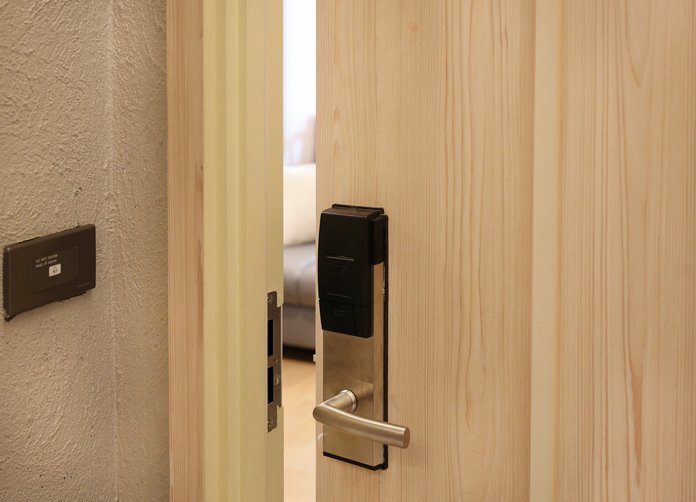
Security and privacy concerns are some of the loudest arguments against the adoption of the Internet of Things in the hospitality industry. Will electronic locks fitted to guestroom doors leave behind an activity log that a malicious hacker can exploit? And can smart TVs in hotel rooms be used to eavesdrop on, or even film, guests? Some smart devices are built with guestroom security in mind, including the following four secure technologies.
1Magnetic Stripe and Smart Cards
Magnetic stripe cards, sometimes called magstripe, contain data embedded in a strip that, when swiped through a reader, can be decoded to facilitate a transaction. The magnetic stripe card has served as a cost-effective hotel room key card for ages. A guest’s basic information is imprinted on the magnetic layer of the card at check-in, with a time limit for its usage usually set until check-out. The electronic door lock is triggered once the magnetic stripe card is read and verified by the door card reader, thereby ensuring that only those authorized can gain access to hotel rooms.
There are, however, downsides to magnetic stripe cards. Occasionally, the magnetic stripe demagnetizes and fails to function. Magnetic stripe cards are also vulnerable to hacking, as hackers can easily read and copy data to steal information or create duplicates.
Smart cards use encryption, smart chip technology, and other cryptography measures to make it very difficult for unauthorized users to access or duplicate information.
2Intelligent Panic Exit
Intelligent panic exits are emergency exit doors fitted with panic bars that are controlled with stand-alone electronic locks. Panic bars are fitted with an orbital latch, which makes opening doors very easy, and have an anti-card device. These features make the intelligent panic exit ideal for improving safety and security. By combining quick panic exits and other smart exit devices, hotels can better protect guests and the property during emergencies.
3Electronic In-Room Safes
Electronic in-room safes are now common in mainstream hotels and resorts as worthy replacements for manual key safes. A personal digital assistant connection is a requirement for opening electronic in-room safes. A unit stores up to 50 incorrect pin entries with time and date stamps. Concerned parties can print audit reports for police and insurance purposes by merely connecting to a computer. Smart electronic in-room safes come in different forms, with the major difference being how data is collected and stored.
4Gangway and Muster Control System
The original application of the gangway and muster control system is in marine vessels to ward off sea piracy. Advanced access control systems make it easy for ship operators to keep records of persons on board at any time. A smart gangway and muster control system comprises a computer system; gangway and muster control software; a camera; a radio frequency identification card scanner; a radio frequency identification card printer and encoder; 200 blank cards; and color ribbons.
In the gangway and muster system application in vessels, all access doors are linked to a control and command center. In the event of an emergency, such as a fire outbreak or the threat of boarding by persons with malicious intent, all access doors can be locked or unlocked in one go. The gangway and muster control system is finding its way into the hospitality industry as a smart option for warding off attacks.
The complexity of systems and the number of devices used by the hospitality industry makes it challenging to ensure all-around safety. Nonetheless, information is stored, in transit, or in-use by these systems, so they must prioritize privacy and security for any hospitality business to thrive.
IoT developers and manufacturers have a vital role to play in upgrading cybersecurity through secure technologies. Every IoT device must be safe for use on its own and the key to achieving this lies with implementing regulatory changes and new practices.












